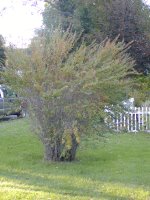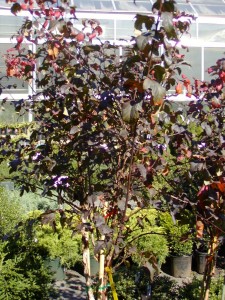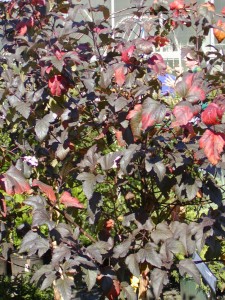 We’ve been looking for a small tree or shrub to replace this old bridalwreath spirea for a few years now. I almost hate to yank it out because it’s been there forever and the mockingbirds sometimes like to nest in it. The center of the shrub is woody and it hardly blooms anymore, so today I went to the nursery around the corner hoping for a bargain. The nursery stock was all 25% off, but I didn’t find anything that grabbed me.
We’ve been looking for a small tree or shrub to replace this old bridalwreath spirea for a few years now. I almost hate to yank it out because it’s been there forever and the mockingbirds sometimes like to nest in it. The center of the shrub is woody and it hardly blooms anymore, so today I went to the nursery around the corner hoping for a bargain. The nursery stock was all 25% off, but I didn’t find anything that grabbed me.
I asked one of the owner’s sons if he might recommend something; he’s always made good suggestions in the past so I trust his ideas. He suggested I consider this Common Ninebark (Physocarpus opulifolius) pictured at right. I liked the reddish purple foliage and the pinkish white late spring flowers sounded nice. I wasn’t sold on it though, so instead took a few pics to show my husband.
always made good suggestions in the past so I trust his ideas. He suggested I consider this Common Ninebark (Physocarpus opulifolius) pictured at right. I liked the reddish purple foliage and the pinkish white late spring flowers sounded nice. I wasn’t sold on it though, so instead took a few pics to show my husband.
I checked my Manual of Woody Landcape Plants by Michael Dirr to see what he has to say about the Ninebark. From the section on landscape value: “Quite coarse and therefore difficult to use in the small home landscape; limited in usefulness because of rather meager ornamental assets; bark on older stems exfoliates into papery strips exposing a rich brow n inner bark; unfortunately, this character is masked by the foliage and dense tangle of stems.” Also, “The Minnesota Landscape Aboretum has a large collection of ninebarks and after looking over the entire group, I still came away with the opinion that about anything is better than a Ninebark.“
n inner bark; unfortunately, this character is masked by the foliage and dense tangle of stems.” Also, “The Minnesota Landscape Aboretum has a large collection of ninebarks and after looking over the entire group, I still came away with the opinion that about anything is better than a Ninebark.“
Well… I guess that answers my question!
Do you have a favorite shrub or smallish tree? Can you suggest something that might be nice as a specimen for full sun in the middle of our back yard? I’d prefer something that blooms and has berries that the birds might find tasty. My husband is inclined to plant a pine, but I want something a bit more showy in such a prominent spot.
Serviceberry. It’s got berries that are edible for both humans and wildlife, beautiful white flowers in spring, single or multi-stem forms, and it can even look decent in winter.
My first thought was Eastern redbud, but it doesn’t have berries. Of course, my first thought for small trees is always redbud….
Others that come to mind, depending on your soil and your preference are: beautyberry, fringe tree, stewartia, or the old standbys like cherry, crabapple or magnolia.
Hey, you asked!
We have a serviceberry by the pond and I love it! Have a star magnolia in the front yard which was meant to stay small, but it’s huge now after just a few years.
Redbud is an idea – I love their color in the springtime.
Funny you should mention Fringe Tree – I had my heart set on one for this spot, but haven’t been able to find them at any of the local nurseries! And I’ve never seen one – only pictures – but they are so pretty.
Can you suggest a particular crabapple – I’ve thought of that, but don’t know a good one.
Thank you for the suggestions.
It doesn’t matter to me what you get as long as it’s NATIVE.
LOL
I can’t suggest a particular crab. I shy away from them for some reason. I guess because they’re everywhere. I went for real apple trees myself, and focused on disease resistant ones. We’ll see how that turns out…
As for the fringe tree, I saw one in early bloom at a flower show and it was gorgeous. I wanted to get one after that. But then I saw one later in the season and I didn’t like it quite as much. The leaves seemed oversized for the tree or something. But I had a particular spot in mind and it didn’t really work for it. I see them in garden centers here in Ohio once in a while, but it’s usually the off-the-beaten-path ones. I’m still tempted to try one some day, but with a new and rather treeless property, I’ve got quite a few things in line ahead of that one.
Going native is always good too.
I was going to suggest serviceberry also. I really like ours now that they’ve begun doing the flowering and fruiting thing.
Buttonbush also came to mind, but the area might be too dry for it. The flowers are attractive to bees and butterflies, the developing capsules are interesting.
A male ginkgo is another possibility, depending on how frequently they’re used there.
I’ll probably be verbally flogged for this somewhere, but what about an autumn olive? Yes yes yes, it’s considered an invasive species – but remember it was Fish & Game depts. that planted ir for the purpose of attracting wildlife. If you plant one bush in your yard, you can control it. It produces lovely yellow flowers in the spring, and bird-magnet berries in the fall. And if you get a bumper crop, you can make wine or jelly! Personally, I love the stuff.
Laura,
My fringe tree is in quite a bit of shade under some oaks, so it is really spreading and looks gangly (sp?). Only female ones have berries (mine has started to bloom, alas no berries).
Although Michael Dirr is a supreme authority for me as well, sometimes his strong opinions can keep you from trying something new. I’ve seen many beautiful nine barks (Longwood Gardens, a friend’s garden) and with interest in all seasons, a lovely vase shape, and the ability to thin out the excess branching, that might be a good choice.
You mentioned that you like the native cranberry viburnum earlier. Mine is planted on the side of my house and is very “shrubby”, not for a specimen plant in the center of a yard.
There are new hardier cultivars of dogwood now — great blooms, red fruit, great fall color, nice branching and native.
Good luck hunting. Enjoy!
Heather
Wayne, PA
How about a tupelo or black gum? I found a wild one here in MA that I love, but I know they are also planted as ornamentals. I don’t know if special varieties are available or not. They have an interesting growth habit with tight, horizontal branches. They turn a beautiful red in the fall. They produce fruit that birds love. They have great dark green summer foliage. They are native.
Susan Gets Native: Of course you would say that!
e4: My husband thinks the crabapples are messy. I would like to see a fringe tree before buying one, but can’t seem to find them in anyone’s garden here. They’re an Asian import, right?
Wayne: I was hoping you might suggest something. I’d love another serviceberry or another viburnum, but am thinking of something with a bit more shape. Will have to look into the buttonbush – I don’t know it.
Laura: Are russian olive and autumn olive the same thing? The one I’m thinking of is pretty, but not sure I could live with it so close to the house – the smell is almost overwhelming! I won’t flog you – there’s a reason those trees are everywhere, thanks to the birds.
Heather: Dirr says the males have the nicest flowers, so there! Some recompense for the lack of fruit.
I would love to find a spot for a cranberry viburnum, but all I have seen look very wild – nice in the right spot, but not for this one. My Winterthur viburnum is barelt hanging on; I may soon have just the spot for the cranberry bush.
Mojoman: Thanks for the suggestion and lovely picture on your blog. I think I looked into the black gum at some point and read that they are difficult to transplant because of the taproot. I might be confusing them with some other tree, though. Worth looking into them again, because I really like the look of them and another tree would be nice in this spot. Thanks again.
I meant to mention that when it comes to trees and shrubs I generally go straight to Dirr (a professor here at University of Georgia, in fact) to see what he has to say. The Big Green Book with Virtually No Pictures!
Another possibility, if you were hankering for a small tree or large shrub but rejecting it because it didn’t make flowers or fruits suitable for birds would be to plant it anyway and then plant a climbing vine that has the qualities you want. Some of the milkweed vines are great, and my favorite of all is coral honeysuckle, Lonicera sempervirens, which provides bright red trumpet flowers in early spring through early summer, and then bright red berries beginning here in August. I’ve got several of these inhabiting various dull trees about the yard.
I don’t want to immediately dismiss non-natives, because many are perfectly good citizens. I draw the line well excluding Autumn Olive and Russian Olive. They are not the same species but they are both Eleagnus. It might be good to see what USDA Plants says about it. Phrases like “invasive”, “banned”, “prohibited” are attached to states like Connecticut, Massachusetts, New Hampshire, West Virginia. The wildlife value as a food source is summarized by two authorities as “low to moderate”.
In hiking about our area, I’ve seen these things coming up in isolated woodlands in massive communities that clearly came from the seeds dropped by birds flying in from elsewhere.
What about a crape myrtle (Lagerstroemia indica). My mother-in-law always loved them and I planted a couple at her house. They are easy to grow since the ones that I put in at her house seemed to take. (my black thumb and all).
http://pubs.caes.uga.edu/caespubs/pubcd/L331.htm
I have a multi stemed serviceberry it blooms in the spring and then has berries which dont last long birds love them and the leaves have a nice deep maroon color in the fall I can email pics of mine if you like..
You do not want a pine tree. They kill anything within 30feet of them.
Wayne: Thanks for the laugh about the Dirr book – it is intimidating, but I love the level of detail and his commentary. I also have the companion book with the glossy pics, but of course it doesn’t cover as much.
I think I may not know the difference between Russian/Autumn olives because I learned them both as “ugly agnes” (a trick to remember the botanical name, I guess) and obviously influenced by my teacher’s bias against this non-native species. I see them growing mostly along the more rural parts of the interstate highways here and creeping into the nearby woods.
Kev: Hi big brother! I’ll drive by the MIL’s house to have a look at those crape myrtles now – they’re beautiful when they bloom, but I don’t know that I’ve ever noticed the bees/butterflies paying them any notice?
Paul: Thanks for the suggestion – I’m enamored of serviceberries too.
Silverlight: We have very few evergreens on our property – only hollies in fact, and I would like to add some others for the shelter they provide. The trouble is there’s only so much room. I might have put them along the property line to keep the ivy at bay, but instead planted viburnums and have to hack at the ivy all time to keep it in the neighbor’s yard.
If you’re still considering a crabapple, I recommend “Dolgo.” Nearly carefree but eventually you’ll have to prune it to keep it small.
You might also be interested in Cornellian cherry (Cornus mas) – small yellow flowers very early in spring before leaves appear. Edible tart fruit very attractive to birds. I use it for jelly sometimes.
How about a Hawthorn? Nice size and shape. Lovely in bloom. Fruit attractive to birds. And thorns – important around here to stop deer from eating them.
But my favorite suggestion – Highbush blueberry. Lovely flowers, great fall color. And the berries… Well, you know, what you don’t eat for breakfast will surely attract birds.
Mary Ann: Thanks. Those crabapples sure look tasty!
I’m feeling fairly overwhelmed with all the suggestions people have made!
There are many plants that can be grown in these wetlands like: red maple, silver maple, carpinus carolianiana, quercus phellos etc. No matter which plant you grow, they will definitely serve the purpose of enriching the natural environment and maintaining the ecological balance. The only thing to be kept in mind is that, you must take the proper guidance and also see with what is your aim of doing the plantation. native plants tree nursery